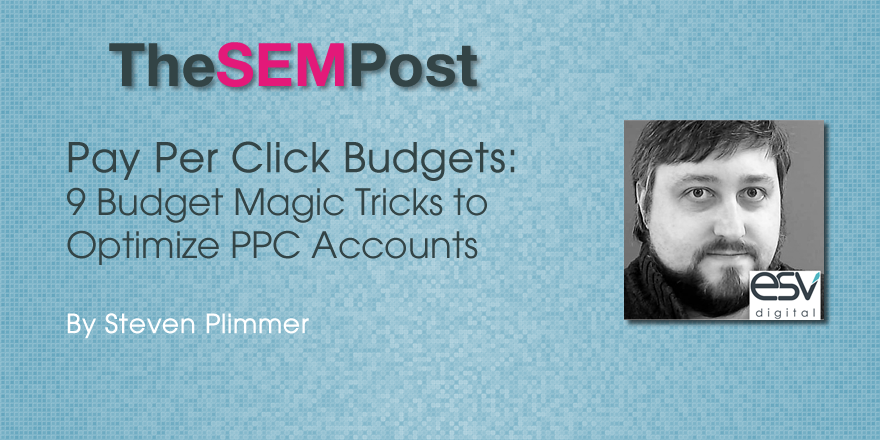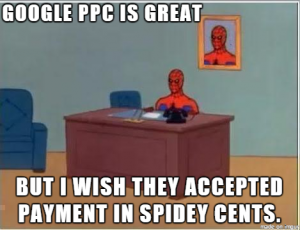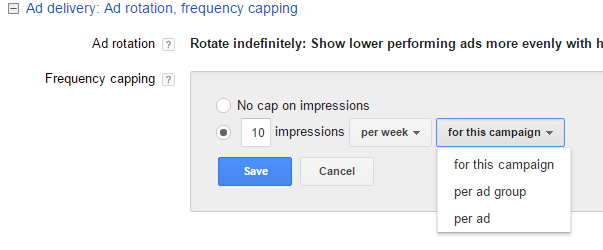 On the surface of it, setting and managing PPC budgets is just a question of “how much am I prepared to spend?” but there are many ways that you can work with budgets to make significant differences to account performance. There is a lot to learn but here I want to look at the techniques you can use that most directly affect campaign performance.
On the surface of it, setting and managing PPC budgets is just a question of “how much am I prepared to spend?” but there are many ways that you can work with budgets to make significant differences to account performance. There is a lot to learn but here I want to look at the techniques you can use that most directly affect campaign performance.

There are different techniques that work in different scenarios. For instance, you may have an unlimited budget, in which case, some of the suggestions below don’t apply but there are often times when you do want to (or have to) limit spend and there are ways to cope with that but still make performance better through budgeting.
- Your budget is capping your spend – you can still get more clicks!
Yes, believe it or not, if you’re ranking pretty high and hitting your budget early in the day or have a low Impression Share (the percentage of times your ads deliver out of the total times it is theoretically entitled to deliver) due to budget, then you can increase clicks by the simple act of reducing bids.
Yes, I said reducing! The reason is simple math – if your clicks cost less, you can get more clicks out of the same cash pile. There is a limit to this, if you’re already ranked in eighth place, you will likely reduce your traffic if you bid so low that you drop off the first page entirely but provided you’re ranked high, this is a sure-fire way of increasing traffic.
- You’re capped by budget – you can get better clicks
You may be delivering all day but you know there are peak periods within the day and the week that sales are going to be coming in their highest numbers and best rate. What do you do if you’re budget is capped? Set ad scheduling. Simply opt out of times when conversion rates are lowest (regardless of volume) and when you have such low volumes of clicks that you would rather spend in the peak time.
In addition, you can set bid levels for the times and days on which you do show to reflect the CPCs and conversion rates (or AOVs) in those periods.
- Shared budgets can cover low budgets and help traffic control
Google Shopping is a great example of where the structure can only easily control the traffic – what products show for certain searches – when the budgets stop and start delivery across the shopping campaigns. So if you are low on budget – or you know you can’t meet demand 100% throughout the day – shared budgets are the way to go.
Also, if your campaign budgets are down to two digits per day, consider shared budgets so that as demand is shown across the account, it can be fed better. Low budgets can strangle delivery in a campaign. If your bids are $0.50 but your budget is $25 on a campaign that could achieve (according to Google estimates) 3000 clicks, Google may hardly deliver the campaign because it does not want to risk giving you free clicks due to spend running way over the budget in 25 minutes. Up to a point, this can be avoided using a shared budget.
- When you use scheduling, use accelerated delivery
Accelerated spend will ensure Google isn’t trying to budget for the whole day when you’re actually choosing to deliver only for a percentage of that day. It will move from dividing the budget by 24 to delivering until the budget depletes. Again, use your judgement, since if your budget is a very long way below the potential traffic, “Standard” delivery will still ensure you deliver on all of your set hours rather than splurging it all in 90 minutes.
- When you want more Brand traffic, try switching to Accelerated Spend
You may have a high impression share on brand terms but you just never know whether you can squeeze more traffic out of Brand until you switch to Accelerated budget spending. It also means you’re prepared for peaks in traffic if SEM is to benefit from a boost from another marketing channel.
- If you have a substantial non-brand campaign and it’s capping, consider restructuring
If you find that two, three or a handful of keywords are spending most of the campaign’s budget, this can mean that you are seeing much less traffic than you could get from all the other keywords. To solve this, give those top spending keywords their own budgets by making single keyword campaigns. Then you can cap them at will (as well as control bids easily) and give the keywords in the original campaign some room to show you what they can do.
- If you have a limited budget and keep hitting it, check Search Partners
If you find you’re spending a healthy chunk of your budget on Search Partner Network traffic (Bing or Google), review this segment’s performance at the campaign level and pause this option entirely if you feel you’re missing out on too much better performing Google-owned and Bing-owned search traffic.
You may find that CPCs are higher on the SE-owned network traffic so the click swap won’t quite be like-for-like but maybe the conversion rate difference will more than make up for that.
- Set Frequency Capping on inefficient GDN campaigns
If you have dabbled in Google Display Network ads – you may not be aware of (or you may not understand) Frequency capping as an option for your ads. This can be an easy way of both improving efficiency and driving reach for these ads.

Frequency Capping is where you set a daily, weekly or monthly limit on the number of times a user will see either any single ad, all your ad group ads or all of your campaign ads. To improve efficiency – if this is not a remarketing campaign and you are heavily capping spend – you will want to reduce the frequency per user so that the clicks you get will be from more people without the need to spend any more.
To drive reach, you would do the same. For remarketing, if you have a massive audience but a low budget, reducing the frequency will, again, ensure more people see your message. If you want to spend less and your budget is not capping spend, this alteration will help you do this but will at the same time increase the diversity of the users seeing the ads and may, therefore, keep sales stable despite reducing spend.
If you want to increase spend but don’t want to spend more per click – increasing the frequency can get you there and for more expensive products or for products and services that involve a lot of shopping around, you will want to have a relatively high frequency on remarketing in any case.
- Capped spend? Try RLSA to reduce traffic from returning customers
On both Brand and non-brand campaigns, if you feel like you want to be less competitive for users who know your site and brand already, you can get them at a cheaper rate and spend your marketing budget more heavily on new visitors by adding a “non-new visitor” remarketing audience to your campaigns (GDN included) and bidding down on this list. This will make returning visitors more profitable and the increase your potential for growth if you have a fixed budget. If you do want growth, however, a fixed budget is not the best way to go about it!
Conclusion
These are a few ways to make your advertising dollars work harder but there are many different scenarios and many different solutions. The trick is to isolate what you’re trying to do – spend less and get more traffic, spend less and get more sales, spend more but not harm efficiency too badly etc.
Once you have the outcome in place and you know if you’re capping and how profoundly, you can decide which direction you want to go in.
Are there any budgeting techniques you swear by or have gotten you out of a pickle?
Tyler Juhola says
Hi Steven,
I enjoyed the article! I wanted to recommend SteadyBudget as well. If you need a system to automatically pause your campaigns across Google, Bing and Facebook when a budget is reached or give you notifications of under/overspending.
-Tyler